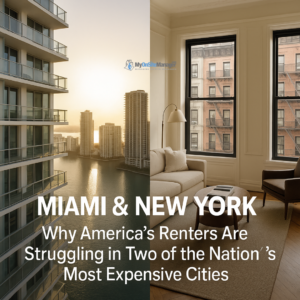For many Americans, the dream of living in a big, vibrant city comes with a reality check: sky-high rental prices that swallow a significant portion of their income. According to a recent analysis highlighted by Cuba en Miami, both Miami and New York City have secured top spots among the most expensive U.S. cities for single renters and the numbers reveal a growing affordability crisis.
As living expenses surge and incomes fail to keep up, renters in these cities face difficult decisions about their budgets, lifestyles, and long-term plans. Here’s a deeper look at what the study shows, why it matters, and how it reflects the shifting landscape of America’s housing market.
New York City: The Cost of Urban Prestige
New York has long been synonymous with high rent, but the latest data underscores just how overwhelming the costs have become especially for single adults.
Key Findings:
-
The average studio apartment costs around $3,375 per month.
-
For a single resident earning the city’s median income of $59,947, rent alone accounts for about 68% of yearly earnings.
-
Affordability becomes even more complicated when examining income disparities:
-
Women pay up to 76.5% of their income on rent.
-
Men spend around 57.9%, still far above the nationally recommended rent-to-income ratio.
-
What’s Behind the High Prices?
New York’s challenges are rooted in a combination of:
-
Chronic housing shortages
-
Strong demand from both domestic and international renters
-
Zoning laws that restrict new construction
-
Limited inventory in affordable or middle-income housing
These economic pressures place renters in a difficult position, forcing many to either downsize, relocate to outer boroughs, live with roommates, or postpone financial goals like saving, investing, or even starting families.
Miami: Sunshine, Beaches… and Soaring Rents
Miami has experienced explosive population growth over the last decade, transforming into one of America’s most desirable coastal metro areas. But with that popularity comes steep competition for housing and rising costs.
Key Findings:
-
The average monthly rent for a studio apartment sits at $2,050.
-
Single renters now spend 54% of their median income on housing.
-
Annual rents continue to climb, showing a 3.22% year-over-year increase.
-
In many Miami neighborhoods, the cost of living is rising faster than local wages.
Why Is Miami Getting More Expensive?
Miami’s affordability challenges are linked to:
-
Increased migration from other U.S. states, especially during and after the pandemic.
-
Limited housing supply, particularly in desirable coastal areas.
-
High investor activity, which drives prices upward.
-
Wage growth that lags behind rental inflation, creating an affordability gap.
These trends hit single renters especially hard, as they shoulder 100% of the cost without sharing expenses with roommates, partners, or family.
The Bigger Picture: Coastal Cities Are Becoming Less Attainable
Miami and New York share several characteristics that make them disproportionately expensive:
1. Coastal desirability fuels demand
People gravitate toward scenic waterfront cities with strong cultural, economic, and entertainment opportunities.
2. Housing supply isn’t keeping up
Construction constraints, limited land availability, and zoning barriers all restrict the number of units that hit the market.
3. Investor-owned units push rents upward
Both cities attract investors who often price units beyond what local wages can comfortably support.
4. Income and rent are growing at different speeds
While rent climbs consistently, median incomes especially in hospitality-driven Miami lag behind.
5. Singles feel the pressure most
Without shared housing costs, single renters pay the full burden, often exceeding healthy financial ratios.
How Do These Findings Compare to Other U.S. Cities?
Not all major cities face these challenges equally. For example:
-
Seattle, although expensive, benefits from high tech-sector incomes that help residents stay afloat.
-
Midwestern cities like Kansas City or Cleveland offer more balanced rent-to-income ratios, providing relief for renters who prioritize affordability.
This contrast showcases the widening divide between high-density coastal hubs and more affordable inland markets.
What This Means for Renters Today
As affordability worsens in key cities, renters may need to rethink their strategies:
Broaden your search
Expanding beyond city centers into nearby suburbs can unlock more affordable options.
Budget realistically
If over 50% of your income is going toward housing, consider adjusting your lifestyle or location to avoid financial strain.
Understand your renter rights
In cities like New York, rent stabilization and tenant protection laws may help.
Consider shared housing
Co-living or renting with roommates can cut costs dramatically.
Plan long-term
If affordability is your priority, emerging cities may offer better opportunities than coastal metros.
Final Thoughts: A Housing Market at a Turning Point
The study makes one thing clear: Miami and New York are becoming prohibitively expensive for a growing segment of the population especially single renters. With rent consuming over half of a person’s income in many cases, the traditional 30% affordability rule feels increasingly outdated.
These trends raise important conversations about:
-
Housing supply
-
Wage growth
-
Urban planning
-
Rent regulations
-
Long-term livability in major U.S. cities
For renters, staying informed is essential. Understanding where the market is headed helps you make the best decisions whether you’re moving, renewing a lease, or comparing cities.

